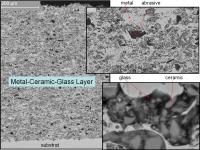(03-31-2015, 06:15 PM)Steamhammer Wrote: Has anyone experimented with coating a substrate in flux or acid prior to flame spraying? I'm spraying with nitrogen for hopefully less oxidation, but I wonder if there's any other way to cut down on it. Any suggestions?
Hi Steamhammer,
In order to increase the adhesion of the layer to the substrate and the cohesion of the layer necessary to eliminate of the oxide films not before spraying but directly into the process (in situ). I use for this three methods (individually or simultaneously):
1. Reducing flame of plasma torch (Ar+H2+N2) and a short spraying distance allows to destroy part of the oxide films (oxides of iron, nickel, cobalt, copper, and some others). The oxide film on the active metal (Cr, Al, Ti, Si, Mg ect) are not destroyed. In the case of flame spraying using nitrogen as carrier gas allows to reduce some oxidation of the powder particles, but does not work against the oxide film on the substrate.
2. Mixing of the abrasive particles in to the powder for spraying allows directly sand blasting of all surfaces during thermal spraying. For this method is necessary a spraying device at a high velocity of particles (HVOF, HVAF or high velosity plasma).
3. Introduction of silicate glass to spraying powder, which act as flux during deposition and destroy all of the oxide films (oxide films dissolves in the melting glass). This method works well at low particle velocities (normal flame spraying) and allows destroy oxide films of active metals.
When used together, these three methods (high velosity plasma device + additive of abrasive particles + additive of silicate glass) can be obtained dense coatings with the adhesion > 150 MPa.

Regards


 SEF Portal
SEF Portal Search
Search Member List
Member List Calendar
Calendar Help
Help


